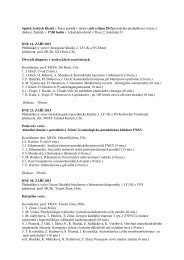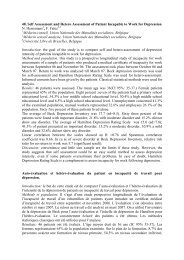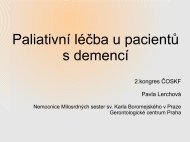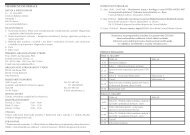ABSTRACTS â ORAL PRESENTATIONS - AMCA, spol. s r.o.
ABSTRACTS â ORAL PRESENTATIONS - AMCA, spol. s r.o.
ABSTRACTS â ORAL PRESENTATIONS - AMCA, spol. s r.o.
You also want an ePaper? Increase the reach of your titles
YUMPU automatically turns print PDFs into web optimized ePapers that Google loves.
P83. DIFFERENTIATION OF NEURAL CREST CELLS FROM HUMAN EMBRYONIC STEM<br />
CELLS AND THEIR ODONTOGENIC INDUCTION<br />
Jan Křivánek 1 , Karel Souček 2,3 , Radek Fedr 2 , Eva Švandová 4 , Eva Matalová 4,5 , Aleš<br />
Hampl 1,3<br />
1<br />
Department of Histology and Embryology, Faculty of Medicine, Masaryk University,<br />
Brno, Czech Republic<br />
2<br />
Department of Cytokinetics, Institute of Biophysics, Academy of Sciences of the Czech<br />
Republic, v.v.i.<br />
3<br />
Center of Biomolecular and Cellular Engineering, International Clinical Research Center,<br />
St. Anne’s University Hospital, Brno, Czech Republic<br />
4<br />
Institute of Animal Physiology and Genetics, Academy of Sciences of the Czech<br />
Republic, v.v.i.<br />
5<br />
Department of Physiology, University of Veterinary and Pharmaceutical Sciences, Brno,<br />
Czech Republic<br />
Neural crest cells (NCC) are transient cell type which differentiates from invaginating<br />
neural plate when two opposite neural folds merge together. These cells are able to<br />
undergo an epithelial-mesenchymal transition, migrate through whole vertebrate<br />
embryo and form many terminal differentiated cell types such as melanocytes,<br />
odontoblasts, Schwann cells, connective tissue cells and many others. From this point<br />
of view NCC represent attractive cell type than can be used in regenerative medicine.<br />
Here we have differentiated human embryonic stem cells (hESCs) into cells possessing<br />
molecular and functional properties of NCC. The key step in the differentiation protocol<br />
was dual inhibition of SMAD signaling in its initial phase followed with FACS-mediated<br />
purification of CD271-positive cells at day 11 of differentiation. The obtained cells were<br />
found, by flow cytometry and immunocytochemistry, to express molecular markers<br />
characteristic of NCC such as HNK1, Sox9, Sox10, and AP2αβ. Importantly, these putative<br />
NCC are also capable of in vitro differentiation into adipogenic cell lineage. When<br />
exposed in vitro to FGF8 these putative NCC up-regulate expression of homeobox genes<br />
that are normally produced early in odontogenesis. Currently, we are investigating the<br />
developmental potential of hESC-derived NCC using chick embryos and also we are<br />
testing the stability of molecular and functional phenotype of these cells when they are<br />
long-term propagated in our modified culture media on dishes coated by poly-L-ornithin<br />
and fibronectin.<br />
This work was supported by: CZ.1.07/2.3.00/20.0185, GAP304/11/1418,<br />
MUNI/A/0962/2012, CZ.1.05/1.1.00/02.0123 and MSM0021622430.<br />
188 Analytical Cytometry VII








